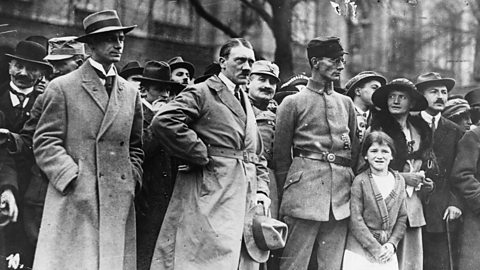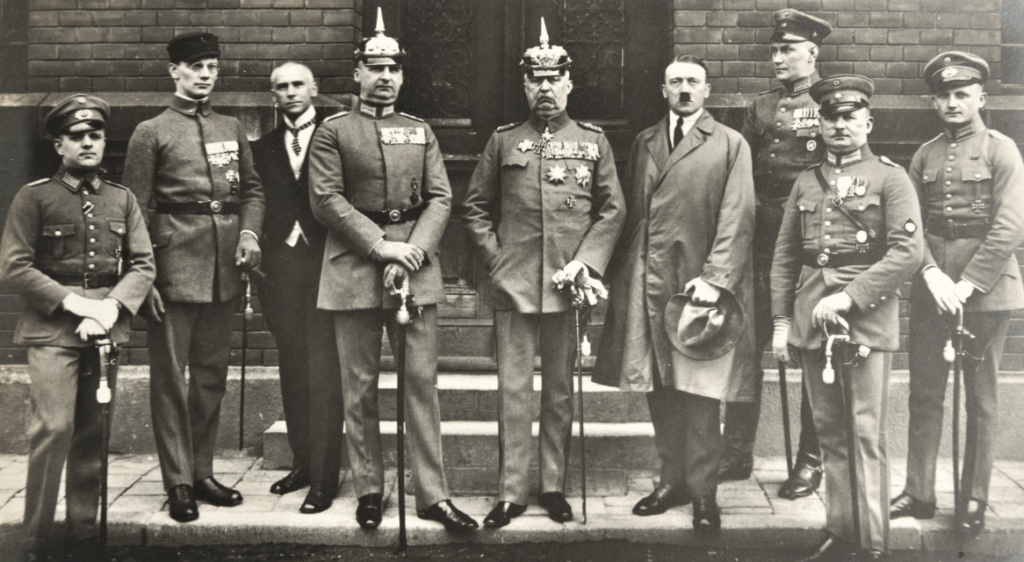By late 1923, hyperinflation was in full swing. To explain simply, hyperinflation was caused when Germany continued to fail to make war payments, leading to the French occupied the heavily industrialised Ruhr province, where much of the industry of the Weimar Republic was, and decided to reclaim payments through more materials. In order to pay them back as soon as possible, the government began printing more money. This led to more cash in people’s pockets, so business owners increased the prices of their products. When the government noticed this, they began to print more money, which led to people having more money, which led to prices increasing, which ultimately led to people hauling around wheelbarrows full of money in order to buy a loaf of bread. And, as I’m sure you’re aware, the more of something you have, the less valuable it becomes. By the end of 1923, 1 US Dollar was worth 4.23 trillion marks.
Many who had savings found them to be worthless and were thus left destitute and penniless, despising the political establishment as it was. Unemployment was through the roof and many Germans began to turn to extreme alternatives to the established government. High ranking members of the Bavarian government organised a meeting at the Bürgerbräu Keller, a beer hall in Munich, to discuss the establishment of an authoritarian regime in Bavaria, that would not adhere to the rules of other Weimar German States, despising the central government’s passive action against the French Occupation of the Ruhr. Hitler, fearing that the Minister-President of Bavaria, Gustav Ritter von Kahr, would pose a threat to his nationalist revolution, he decided to act.

At around 8:30 in the evening of November 8th, 1923, where Bavarian officials, including von Kahr as well as General Otto von Lossow and Chief of Bavarian Police Hans Ritter von Seisser, were having their meeting, Hitler stormed into the beer hall with his personal body guard, firing his pistol into the air. “National revolution is underway!” he cried. He then proceeded to state that the Bavarian government had been deposed and that it was now simply a matter of the central government, which was a massive lie. Hitler’s plan was to mimic Benito Mussolini’s March on Rome, taking Berlin by force.
He organised Kahr, Lossow and Seisser into a backroom and forced them to cooperate at gun point. Meanwhile, the SA was tasked with securing communications lines and seizing local government authorities. However, this is when things began to go down hill very quickly. The SA only managed to seize a handful of government buildings. In addition, Hitler left the trio in the hands of Erich Ludendorff, a former World War 1 General and fervent German Nationalist, who let them go, under the pretense that they would go and assist in the revolution. They did not, instead ordering the military and police to suppress the Nazis.

Agitated, Hitler paced around the beer hall for hours, thinking on what to do next now that his three points of leverage had gone, enabling the military and police to set up blockades around the city. Eventually, Hitler rallied some 2,000 men to march on the Feldherrnhalle, a Bavarian Army war memorial from the 19th Century. After marching for some distance, the group encountered an armed police presence. After pausing for a moment, they continued to march, and the police opened fire.
With over a dozen Nazis dead and four police officers killed in a shootout, Hitler had fled and went into hiding. He was eventually captured two days later and put on trial for high treason in February 1924. High treason carried a sentence of life imprisonment. Despite the multiple other crimes perpetrated during the putsch, such as the murder of the police officers and the assault of Jewish citizens of Munich, Hitler, as well as other Nazis were only tried for treason. The right leaning judge, Georg Niendhart was incredibly lenient on Hitler.

Whilst the Bavarian government wanted to keep the trial on the down low as much as possible, Hitler wanted to make a scene, often erupting into fiery speeches, interrupting court procedure and telling his entire life story, interjections that the judge actively enabled. Because of this, Hitler’s public profile grew over the course of the trial. Whilst he was found guilty, Niendhart only sentenced him to 5 years at Landsberg Prison, of which he only served nine months. His cell was incredibly luxurious and he was treated incredibly well, often having meetings with party members.

He also began to work on Mein Kampf, his autobiography and political manifesto. Much of the book contained antisemitic and racist talking points.
Races which are culturally superior but less ruthless would be forced to restrict their increase, because of insufficient territory to support the population, while less civilized races could increase indefinitely, owing to the vast territories at their disposal. In other words: should that state of affairs continue, then the world will one day be possessed by that portion of mankind which is culturally inferior but more active and energetic. A time will come, even though in the distant future, when there can be only two alternatives: Either the world will be ruled according to our modern concept of democracy, and then every decision will be in favour of the numerically stronger races; or the world will be governed by the law of natural distribution of power, and then those nations will be victorious who are of more brutal will and are not the nations who have practised self-denial.
Hitler’s writings in Mein Kampf
Eventually, Hitler was released from prison. It was then that he realised that the Nazis could not take over a nation by force. In order to create a “racial state” he could not do it from the outside in but from the inside out.
